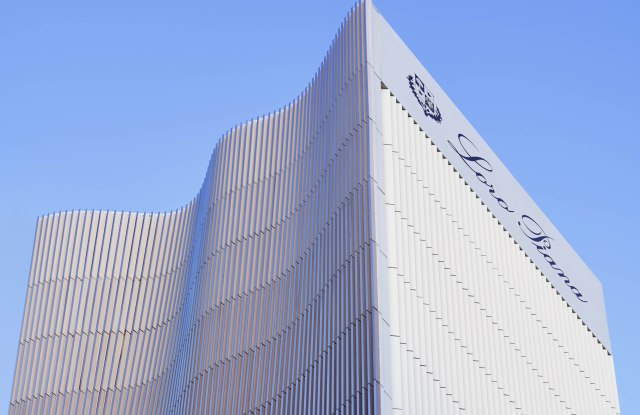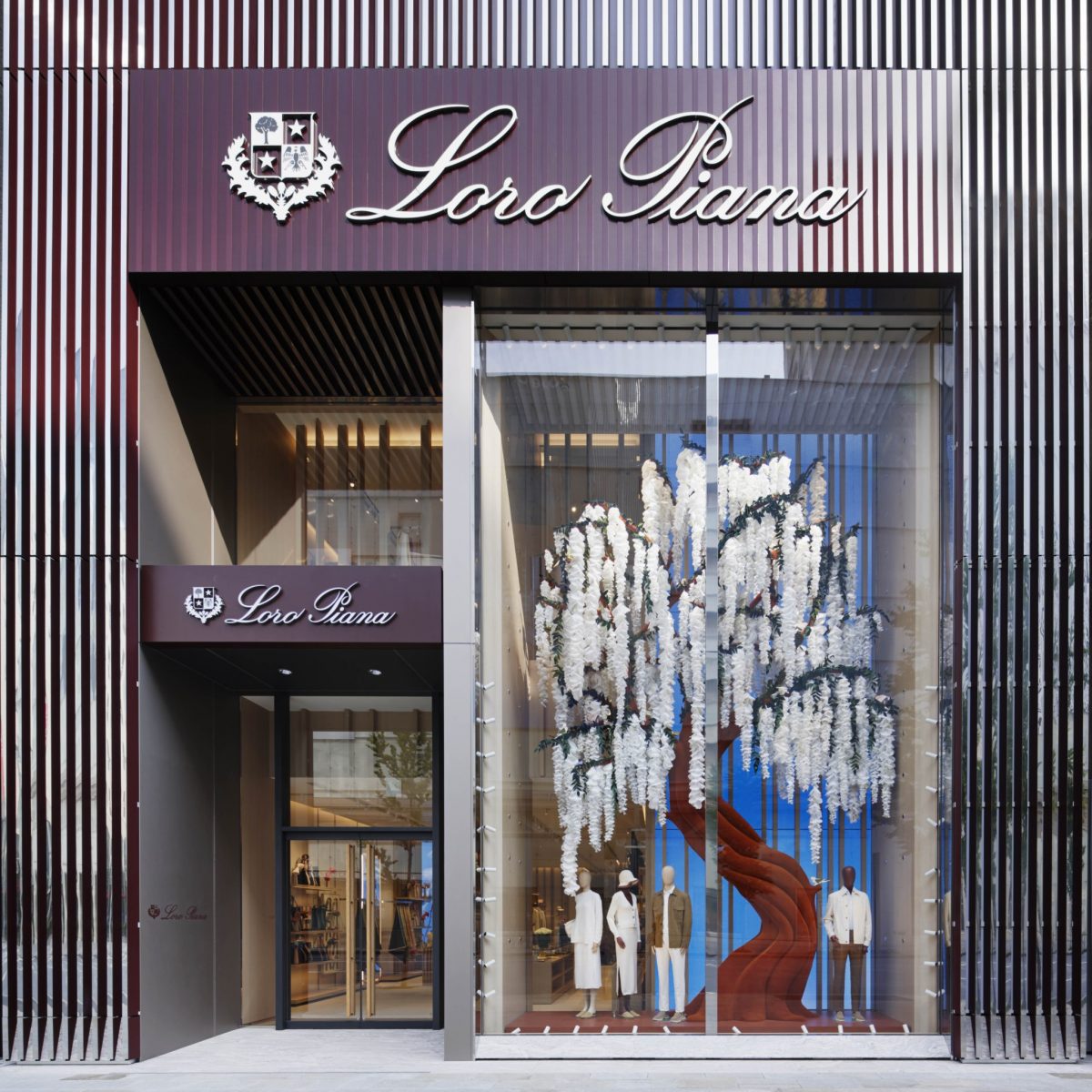The Italian luxury company has opened a store designed by Jun Aoki with a striking facade inspired by the brand’s textiles.

Loro Piana’s precious and soft textiles moved by the wind were the inspiration for the vibrating texture of the facade of the brand’s new flagship in Tokyo’s Ginza.
“This is the first time we express the brand through architecture and the facade is up to our ambitions, given the impact of the building, which is so evocative of the brand,” said Loro Piana chief executive officer Fabio d’Angelantonio proudly. “We’ve long wanted to have a presence in Ginza and the brand has a storied presence in Japan, so this is a very symbolic and important moment for us.”
Due to the coronavirus restrictions, the opening of the store was postponed from April to early last week, representing a sign of hope for the future. The company is evaluating the possibility of holding an event to mark the opening in the second half of the year, “at the most opportune moment,” d’Angelantonio said.
The building was designed by architect Jun Aoki and the facade, more than 100 feet high, is comprised of mirrored steel strips with an extremely fine laminate. Because the vertical elements are rotated at an angle of three degrees, the reflected images become fragmented, creating a sense of dynamism, and luminous, thanks to the micro-perforated fabric placed behind the ribs. Louvers are used on its surface to give an image of countless vertical lines of fiber threads. This is the only facade on the street that is not flat.
The iridescent shades of Loro Piana’s fabrics and the brand’s staple color, kummel, are also key elements of the building, fully saturated at the base and fading into white at the top. While striking, d’Angelantonio contended the architecture reflects Loro Piana’s understated elegance and it is evocative of “the tactile experience so important to enjoy the brand’s fabrics. A scarf is simple yet sophisticated.”
Aoki has worked with Loro Piana’s parent company, LVMH Moët Hennessy Louis Vuitton, on a number of Louis Vuitton stores.
Preparing for the opening, d’Angelantonio toured Japan with his wife as a tourist for two weeks, before the COVID-19 pandemic, to absorb “the deeper elements” of the country’s culture, visiting, for example, the island of Naoshima, known for its art museums, sculptures and architecture.
“I think that the long history of Loro Piana in Japan reflects how the brand fits with the country, where customers appreciate authenticity, the six generations of the family’s passion for natural fibers, tradition, love of quality, craftsmanship and details.”
Touching his own white André shirt, the executive cited it as an example, as a shirt that has no piping or stitching on the revers of the collar. “There’s a Japanese word, Iki, that expresses simplicity and understatement, but masks sublime quality at the same time,” he said, drawing parallels with the Loro Piana brand.
D’Angelantonio said Loro Piana’s men’s fabrics have been available in Japan for at least 50 years. “This is a strategic opportunity for us, Japan is one of our first and main markets, but this is also the first time the company has a store of such a size in Japan.”
There are 17 Loro Piana stores in Japan, of which three are freestanding. Globally, the company counts 130 banners, with a limited wholesale distribution.
“The health emergency in Japan was contained, and we wish to make a statement of optimism,” continued d’Angelantonio. “We expect a gradual return and we have positive expectations for the second half. We are also planning a number of cultural activities to create interest in the next weeks, such as the exhibition of photographer Yoshihiko Ueda kicking off the series.”
Neutral hues characterize the interiors of the four-level store, where fabrics represent around 85 percent of the materials used in the design of the unit — all from the Loro Piana Interiors collection. “We want to emphasize the sense of touch,” the executive said.
In sync with Loro Piana’s understated nature, the logo is subtle, not appearing on the top front of the building. In an additional tribute to Japan, “a love letter” to the country, a symbolic beautiful wisteria tree made of rice paper stands in a 26-foot-high window.

The ground floor is dedicated to textile accessories and leather goods, for both men and women. Women’s collections are available on the first floor, while the second floor is dedicated to men’s wear. The top floor offers the most extensive customization services to be found in any Loro Piana store in the world: Made to Measure for formal dressing and Made to Order personalization available for knitwear in cashmere and Baby Cashmere, footwear and accessories. This space offers privacy for dedicated appointments, with a special entrance if required.
A capsule collection in a fabric made from the lotus flower and a dedicated handbag were made exclusively for the Ginza store. “Storied products are developed in the kummel color to celebrate the opening of the flagship, and, paying tribute to Japan, the hue is christened Ginza here,” d’Angelantonio said.

Japan is also an inspiration for the brand. “There is a reverse experience where we can be stimulated for product development. In fact, we were motivated to once again use the lotus flower, woven with silk warp, for a fresher and incredibly modern and resistant fabric,” he explained.
Loro Piana has been helping to save the ancient tradition of spinning yarns from the lotus flower. The fabric obtained is crease-free and breathable and woven with silk; it features in the men’s and women’s capsule exclusive for the Ginza store. This includes the Traveller Jacket, in a natural ecru color; the Hoodie, a casual bomber jacket with zip and hood, and accessories including a baseball hat and the Traveller Walk, a Seventies style sneaker with calfskin details. There is also the S-Cape, a poncho obtained by combining two large stoles, here in blue or natural cashmere and silk, edged in the lotus flower and silk fabric, as well as two large hand=made scarves in cashmere, silk and fine lotus threads.
The Zellige Bag also makes its debut, in butter soft glacé napa as well as the Inside Out, developed in the tones of the building designed by Aoki.

The company is also allowing customers to be creative, personalizing cashmere and Baby Cashmere knitwear available in 42 colors and 26 models, for both men and women, with or without initials. “We believe the customer is discerning and this is an opportunity to co-create unique pieces.”
COVID-19 and the extended lockdowns globally have accentuated self-gratification, d’Angelantonio noted. “We want to be comfortable, yet elegant, and cashmere sweatshirts, pants, and our plaids are very much in demand. Who is connecting on Zoom calls in a jacket and a tie? At the same time, fabrics for interiors are increasingly important since we spend more time at home. And the comfort of fabrics is central.”
Like many of its peers, Loro Piana saw an acceleration in online sales, although d’Angelantonio admitted the performance could not balance the closing of the brick-and-mortar stores. The pickup in e-commerce, he believes, “will not stop and the digital tools will evolve, expanding the opportunities,” helping the interactions be “more natural,” but will only be “an addition” to our lives. D’Angelantonio said he was still thinking about “a probable virtual presentation” in September.
As per LVMH’s guidelines, D’Angelantonio did not disclose the company’s revenues, but said Loro Piana’s business is well-balanced across major markets. “The brand is in good health, for both the men’s and women’s divisions. China was already important for us and is in good health now, showing more ability to contain the virus together with [South] Korea. Chinese travel less and but they are buying more locally.”
He admitted the U.S. is a “very difficult” market now, impacted by the social tensions, but “it was delicate even before the pandemic, since it’s an election year and given the issues affecting department stores.” That said, he was “quite optimistic” in light of the “internal positive dynamics in the country.”
So much so that, following the opening of a pop-up in the Meatpacking District in Manhattan, a store will open in the second half of the year there and a unit will open in Silicon Valley next year.

